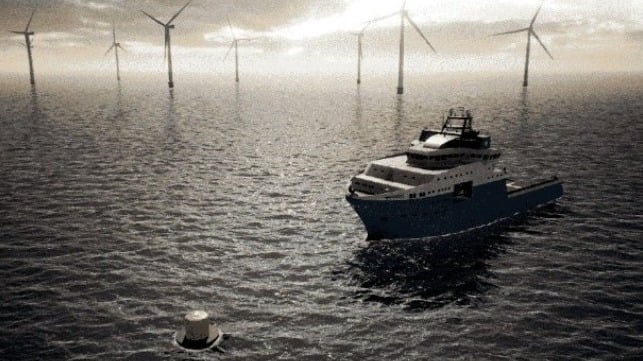Offshore Charging Buoy Extends Shore Power Benefits to Sea

A unique new program is looking at extending the concept of shore power to vessels moored or anchored at sea, providing the same environmental benefits as those achieved in ports. The proto-type buoy under development will act as both a safe mooring point and as a power source for vessels substituting fossil-based fuels with green electricity, thereby eliminated virtually all emissions while the buoy is in use.
The prototype buoy has been developed by Maersk Supply Service in partnership with Ørsted, a leader in offshore wind. The Danish Maritime Fund provided initial co-financing to conceptualize the project and Maersk Supply Service also received a DKK 22 million ($3.5 million) EUDP grant (Energy Technology Development and Demonstration Program, under the Danish Energy Agency) in 2020 supporting the engineering and demonstration of the power buoy.
According to the partners, the charging buoy that can bring green electricity to offshore wind farm service vessels and potentially to a wide range of maritime vessels. The buoy can be used to charge the smaller battery- or hybrid-electric vessels and to supply power to larger vessels, enabling them to turn off their engines when laying idle. They believe the technology will be applicable as a mooring point outside ports, in offshore wind farms, and near vicinity to other offshore installations.
“The charging buoy tackles a multitude of problems; lower emissions, offering a safe mooring point for vessels, better power efficiency, and eliminating engine noise. This is also a solution that can be implemented on a global scale, and one that can be adapted as the maritime industry moves towards hybridization and electrification,” says Jonas Munch Agerskov, Managing Director for Offshore Renewables at Maersk Supply Service.
Maersk Supply Service developed the prototype while Ørsted is responsible for the buoy’s integration with the electrical grid at the offshore wind farm. The charging buoy will be tested in the second half of 2021, where it will supply overnight power to one of Ørsted’s service vessels.
Upon technical validation and commercial ramp up, the partners say that the electrical charging buoy has significant potential, short to medium term, to contribute positively to reduce emissions for the maritime industry. This will happen through displacing tens of thousands of tons of fuel consumed every year in the wider maritime sector by enabling inactive vessels to turn engines off and replace energy consumption and charge batteries with renewable electricity. Within five years of global operation, Maersk Supply Service has the ambition to remove 5.5 million tons of CO2, additionally avoiding particulate matter, NOx, and Sox.
Ørsted also intends to make any intellectual property generated in designing the integration of the buoy into the offshore wind asset publicly available to maximize the uptake potential of this carbon reduction innovation across the offshore wind sector.
